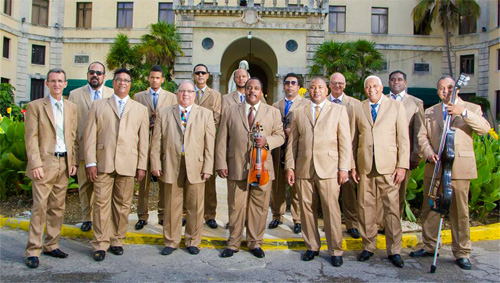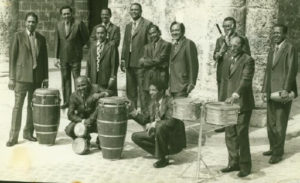 LA ORQUESTA ARAGÓN, UNA OCTOGENARIA AGRUPACIÓN MUSICAL CUBANA CELEBRA SU FUNDACIÓN.
LA ORQUESTA ARAGÓN, UNA OCTOGENARIA AGRUPACIÓN MUSICAL CUBANA CELEBRA SU FUNDACIÓN.
Fundada en Septiembre de 1939 en Cienfuegos, ciudad del centro sur de Cuba, la popular orquesta Aragón representa y da nombre a las charangas aparecidas a principios del siglo XX en la Isla.
Bajo la creación de Orestes Aragón Cantero, de profesión carpintero, nació la agrupación en la que se destacaban sus tres violines, la flauta y el cello; describiendo la música de cuerda que se tocaba originalmente en los bailes y fiestas de salones de los años 40.
Actuó por primera vez en público el 9 de octubre de ese año, en un baile celebrado en la urbe cienfueguera, tiempos en que actuaban en la local radioemisora CMHD.
Es la única orquesta cubana que ingresa, el 7 de abril de 1999, en el Salón de la Fama de la Música Latina, en Nueva York; agrupación de más trascendencia en la música cubana del siglo XX.
El 7 de agosto de 1955, se instaló en La Habana, contratada para grabar un programa diario en la emisora Radio Progreso. Con el tiempo, el chachachá -más que el ritmo- es fiel compañero con el estilo que marcaría uno de los secretos de su mito.
En sus ocho décadas de trayectoria, dentro y fuera del país, ha interpretado éxitos como El Bodeguero, El cerquillo, Cachita, Pare Cochero, Guajira con tumba y, Tres lindas cubanas, entre otros.
Con su típico ritmo hizo voltear la mirada de los bailadores, nuevamente, hacia los ritmos nacionales, como el son, el bolero y la rumba, asediados por la música norteamericana, en particular el rock and roll.
La Aragón ha sido definida como Los Estilistas del Chachachá y registró voces como las de Benny Moré, Dámaso Pérez Prado, Félix Chapotín, entre otros importantes intérpretes.
Orlando Vallejo fue el solista que más cantó con la orquesta, y también lo hicieron Los Zafiros, Elena Burke, Omara Portuondo, Moraima Secada, Silvio Rodríguez, Fernando Álvarez, Joseíto Fernández entre otros.
Desde su repertorio inicial (conformado por danzones, boleros, guarachas y otros géneros de la música cubana), devino principal intérprete del triunfante género del chachachá, adueñándose de ese ritmo que hizo famoso al inolvidable flautista Rafael Egües, quien estuvo en la orquesta hasta 1984.
A su amplísima producción discográfica (LD y CD), se suman los impresos en Cuba, Estados Unidos, México, Colombia, Venezuela, República Dominicana, Francia, Reino Unido, España y Japón, en donde se han grabado discos desde 1953 hasta la actualidad.
Su quehacer musical es reconocido y aclamado por públicos en escenarios de varias latitudes y relevantes cantantes latinos, como Tito Puentes, Gilberto Santa Rosa y Oscar D´León.
En la celebracion de la octogenaria fundacion de esta magnifica agrupacion, se enorgullece de seguir apegada a la sonoridad que la ha caracterizado, manteniendo un estilo nuevo, sin perder la tradición de sus predecesores.
La Aragón y sus integrantes bajo la batuta de su director Rafael Lay, hijo, apuestan con su valía en el pentagrama musical por mantenerse en el gusto de los bailadores la música cubana.
 THE ORCHESTRA ARAGÓN, AN OCTOGENARIAN CUBAN MUSICAL GROUP CELEBRATES ITS FOUNDATION.
THE ORCHESTRA ARAGÓN, AN OCTOGENARIAN CUBAN MUSICAL GROUP CELEBRATES ITS FOUNDATION.
Founded in September 1939 in Cienfuegos, a city in southern-central Cuba, the popular Aragón orchestra represents and gives its name to the charangas that appeared at the beginning of the 20th century on the Island.
Under the creation of Orestes Aragón Cantero, of carpenter profession, the group was born in which his three violins stood out, the flute and the cello; describing the string music that was originally played at dances and ballroom parties of the 40s.
He performed for the first time in public on October 9 of that year, in a dance held in the city of Cienfueguera, at which time they performed at the local radio station CMHD.
It is the only Cuban orchestra that enters, on April 7, 1999, in the Latin Music Hall of Fame, in New York; a grouping of more importance in Cuban music of the twentieth century.
On August 7, 1955, he settled in Havana, hired to record a daily program on the Radio Progreso station. Over time, the chachacha – more than the rhythm – is a faithful companion with the style that would mark one of the secrets of his myth.
In his eight decades of experience, inside and outside the country, he has performed hits such as El Bodeguero, El cerquillo, Cachita, Pare Cochero, Guajira con tomb and, Tres linda cuanas, among others.
With his typical rhythm, he turned the gaze of the dancers, again, towards national rhythms, such as son, bolero, and rumba, beset by American music, particularly rock and roll.
La Aragón has been defined as Los Estilistas del Chachachá and recorded voices such as those of Benny Moré, Dámaso Pérez Prado, Félix Chapotín, among other important interpreters.
Orlando Vallejo was the soloist who sang most with the orchestra, and so did Los Zafiros, Elena Burke, Omara Portuondo, Moraima Secada, Silvio Rodríguez, Fernando Álvarez, Joseíto Fernández among others.
From his initial repertoire (made up of danzones, boleros, guarachas and other genres of Cuban music), he became the main performer of the triumphant genre of chachachá, taking possession of that rhythm that made the unforgettable flutist Rafael Egües famous, who was in the orchestra until 1984.
To his vast record production (LD and CD), the printed ones are added in Cuba, the United States, Mexico, Colombia, Venezuela, Dominican Republic, France, United Kingdom, Spain, and Japan, where records have been recorded from 1953 to the present.
His musical work is recognized and acclaimed by audiences on stages of various latitudes and relevant Latin singers, such as Tito Puentes, Gilberto Santa Rosa, and Oscar D´León.
In the celebration of the octogenarian foundation of this magnificent group, it is proud to remain attached to the sonority that has characterized it, maintaining a new style, without losing the tradition of its predecessors.
La Aragón and its members under the baton of its director Rafael Lay, Jr., bet with their worth on the musical stave to keep Cuban music in the taste of dancers.
Agencies/ RHC/ Guadalupe Yaujar/ Internet Photos/ YouTube/ Arnoldo Varona/ www.TheCubanHistory.com
THE CUBAN HISTORY, HOLLYWOOD.








